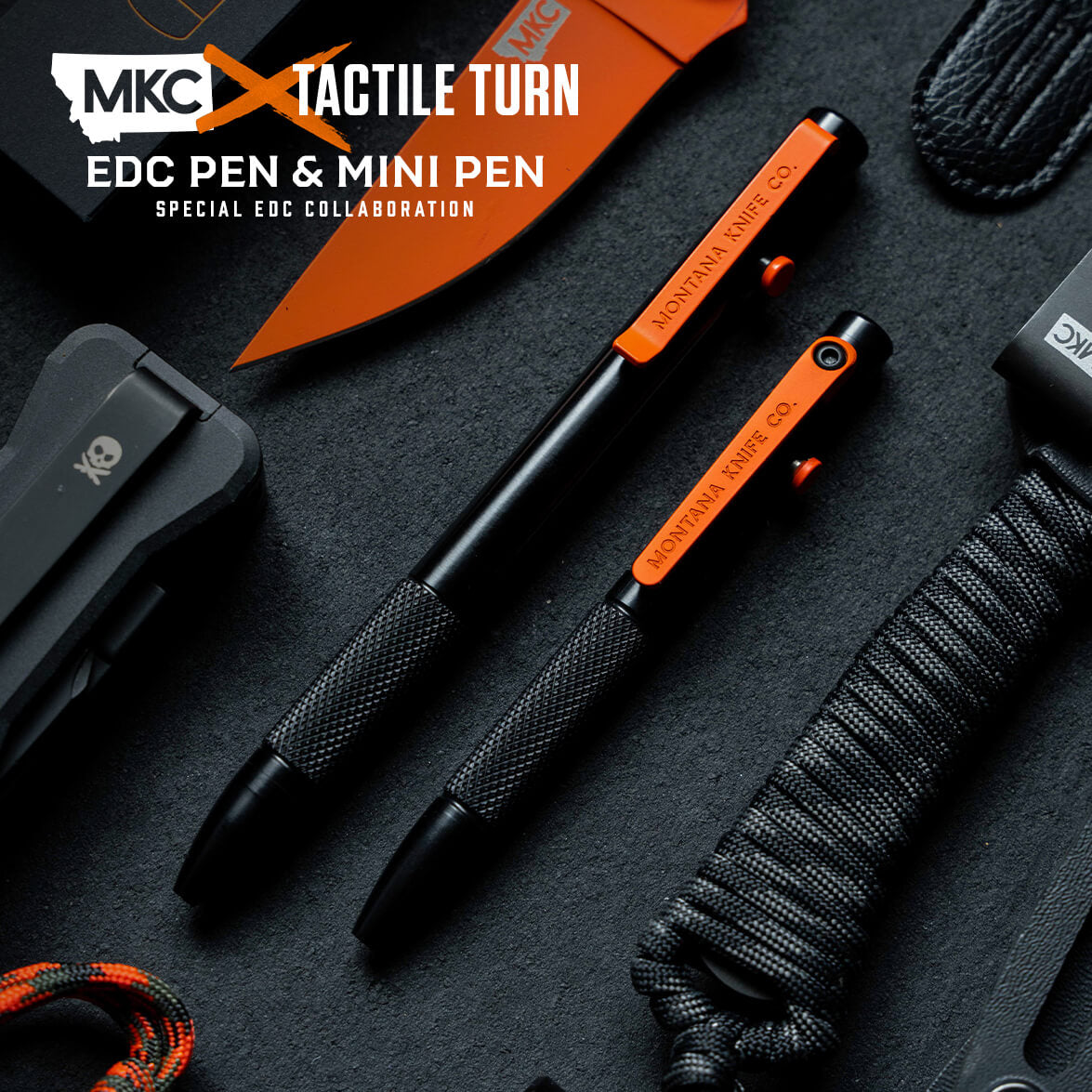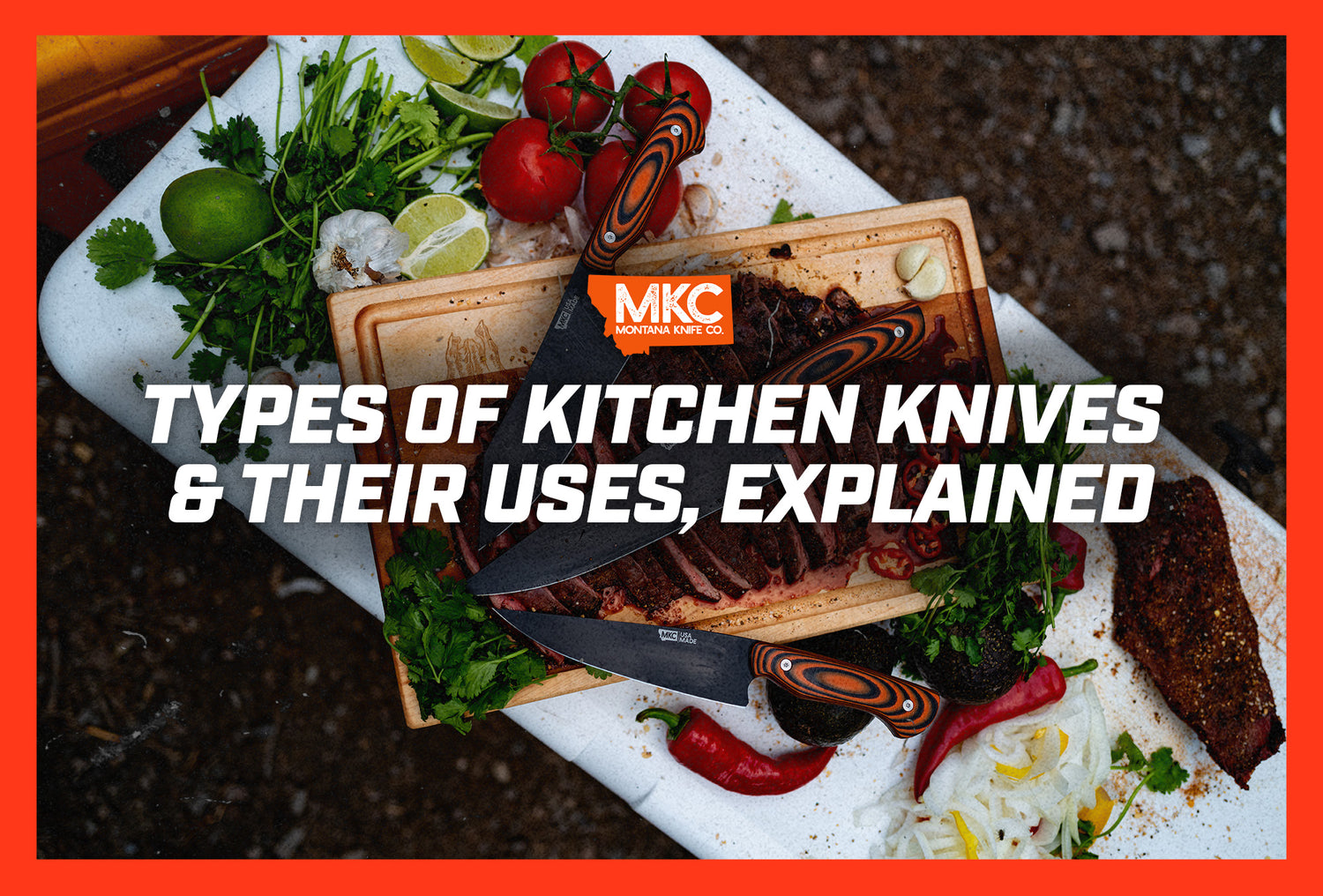At Montana Knife Company, we’re known for our hunting knives’ sharpness and durability. However, a good knife’s importance doesn’t start and end out in the woods. A good knife should be equally useful in your kitchen, no matter what you’re cutting.
It’s time to up your knife game. Here are all the types of kitchen knives that should have a place in your toolkit — and why.
Choosing Your Steel
Most custom knives are made of one of two materials: carbon steel or stainless steel.
Carbon steel knives mostly contain iron and carbon, with a few other trace elements. They come in low-, medium-, and high-carbon varieties. High-carbon steel is hard but can be brittle. Low-carbon steel is softer and more flexible. Medium-carbon steel strikes a balance between the two.
Carbon steel knives excel in toughness, forgeability, and affordability. Plus, they’re easy to sharpen. However, they rust and corrode more easily, especially when stored incorrectly.
Stainless steel knives contain at least 10.5% chromium, as well as other trace elements. Stainless steel comes in many formulas, but it doesn’t have high-carbon and low-carbon variants like carbon steel.
Stainless steel is more heat- and corrosion-resistant than carbon steel. Because of this, MKC’s kitchen knives are all made of stainless steel. It’s also low-maintenance and aesthetically pleasing. However, stainless steel is pricier than carbon steel, and these types of kitchen knives can be more difficult to sharpen.

The Must-Have Blades in Your Kitchen
There are hundreds of types of kitchen knives on the market today. It’s easy to get overwhelmed by all the options.
Here at MKC, we consider the Santoku knife, the petty knife, and the chef’s knife to be the “big three.” Whether you cook your meals out in the field or back in the kitchen, these three knives serve every need.
Santoku
The Santoku is an all-purpose kitchen knife created in Japan for speed, precision, and balance. It excels at chopping, mincing, dicing, and slicing. Traditionally, chefs use Santoku knives for cutting vegetables, but these knives can also process meats, herbs, and seafood.
We designed our Smith River Santoku with an ergonomic handle and a sharply angled heel for comfortable extended use. The wide blade makes scooping chopped goods off your cutting board quick and easy.
Petty
The petty knife is another general-purpose blade. Similar in size to a paring knife, the petty excels at delicate tasks where a larger knife might struggle. Whether you’re peeling a tender vegetable or separating joints on a carcass, the petty will excel.
You’ll like the Little Bighorn Petty if you feel most comfortable with a small, maneuverable knife. Plus, we designed the MKC Petty with a slightly wider blade than similar types of kitchen knives. This keeps the blade robust and functional both in the kitchen and out in the field.
Chef’s Knife
The chef’s knife is undeniably the king of the kitchen. If you only bring one type of kitchen knife with you on your next trip, make it the chef’s knife. There’s a reason for its name — the chef’s knife should be your best friend in the kitchen.
We designed the eight-inch Bighorn Chef to be ergonomic, comfortable, tough, and beautiful. The Bighorn can do everything from carving a roast to slicing French fries, but it really shines when breaking down large cuts of meat.
Specialty Knives
While the three types of kitchen knives listed above will fill most roles, all three are multi-purpose blades. Sometimes you need a purpose-made knife to get the job done. You’ll find those options below.
Cleaver
A cleaver is a heavy, flat knife with a chunky handle. It resembles a stubby hatchet, and like a hatchet, it’s made for chopping. A cleaver can “cleave” through thick cuts of meat and even soft bones. The wide, flat blade of a good cleaver can also crush foods like garlic and nuts.
The cutting edge of a cleaver must be stronger than a standard kitchen knife. However, it doesn’t need to be especially sharp. A tough, shatter-proof cleaver is much more desirable than one with a razor-sharp edge.
Boning Knife
A boning knife is a medium-sized, narrow blade made for preparing meat and fish. While similar to a fillet knife, a boning knife is stouter, shorter, and less flexible. Boning knives are excellent for deboning meat, as the name suggests.
A good boning knife glides along bone without splintering it. It should have a sharp edge that makes long, deep cuts easy, even through knuckles and connective tissue. If you process a lot of meat, a boning knife is a great addition to your kit.
Fillet Knife
A fillet knife is a medium-to-long knife with a highly flexible blade. As the name implies, fillet knives work best for filleting fish. A good fillet knife can glide along the backbone and under the skin of a fish, separating them from the meat.
Like the boning knife, the fillet knife has a large belly and a very sharp point. It’s meant to slice with long, gentle strokes instead of short, sawing motions. Avid fishers should always have a good fillet knife, like the MKC Flathead Fillet, in their kit.
Paring Knife
A paring knife is a common kitchen knife used for small, precise tasks. It should have a sharp edge suitable for delicate cuts. These types of kitchen knives usually only reach two to four inches in length.
Paring knives work well for peeling vegetables and fruits. A good one can also de-vein shrimp, pit cherries, hollow peppers, and more.
Steak Knife
A steak knife isn’t a cooking or utility knife, but you’ll want one in your kitchen all the same. A good steak knife makes cutting and eating a great steak easy — hence the name.
They come in many styles and sizes, and most modern steak knives have a serrated edge. Serrated-edge steak knives are supremely durable and don’t need as much sharpening as non-serrated knives.

Types of Kitchen Knives: Final Thoughts
Whether you’re brand new to culinary knives or your is collection decades old, this guide should help you fill in the missing pieces.
There are many types of kitchen knives out there, and you by no means need one of each to get the job done. Now that you know the basics, it’s up to you to decide which types of kitchen knives suit your needs.
by Josh Smith, Master Bladesmith and Founder of Montana Knife Company






































